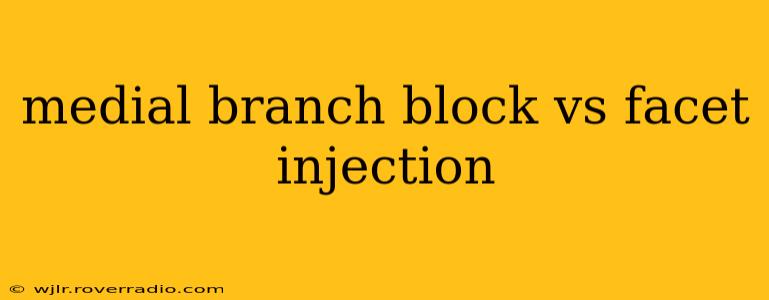Medial Branch Block vs. Facet Joint Injection: Understanding the Differences
Chronic neck or back pain can be debilitating, leading many to explore various pain management options. Two common procedures used to diagnose and treat spinal pain are medial branch blocks and facet joint injections. While both target similar areas of the spine, they differ in their approach and applications. This article clarifies the distinctions between these procedures, answering common questions and providing a comprehensive understanding of each.
What is a Medial Branch Block?
A medial branch block is a diagnostic and therapeutic procedure targeting the medial branches of the dorsal rami nerves. These nerves transmit pain signals from the facet joints (the small joints connecting the vertebrae in your spine) to the brain. The procedure involves injecting a local anesthetic (like lidocaine) and sometimes a corticosteroid medication near the medial branches. If the pain is reduced after the injection, it suggests the facet joint is the source of the pain. This confirms the diagnosis and helps determine the next steps in treatment.
What is a Facet Joint Injection?
A facet joint injection, also known as a facet joint nerve block, directly targets the facet joint itself. A local anesthetic and often a corticosteroid are injected into the joint capsule, aiming to reduce inflammation and pain originating from the joint's structures. Like medial branch blocks, facet injections serve both diagnostic and therapeutic purposes. A successful injection indicates the facet joint as the source of the pain.
H2: What are the Key Differences Between a Medial Branch Block and a Facet Joint Injection?
The primary difference lies in the injection site: medial branch blocks target the nerves supplying the facet joint, while facet joint injections target the joint itself. This seemingly small difference influences the procedure's impact and suitability for different situations. Medial branch blocks are often preferred for diagnosing the source of pain, as a successful block strongly suggests facet joint involvement. Facet injections are frequently used therapeutically to provide longer-lasting pain relief, especially when inflammation is a significant factor.
H2: Which Procedure is Right for Me?
The choice between a medial branch block and a facet joint injection depends on several factors, including:
- The location and nature of the pain: The specific spinal level affected and the type of pain (e.g., sharp, dull, aching) will guide the physician’s decision.
- The goal of the procedure: Is the primary goal diagnosis or pain relief? Medial branch blocks are often better for diagnosis, while facet injections are generally better for providing longer-lasting therapeutic pain relief.
- Patient medical history and overall health: Pre-existing conditions can influence the suitability of either procedure.
Your doctor will consider these factors when recommending the most appropriate approach for your individual case. They will discuss the risks and benefits of each procedure before proceeding.
H2: What are the Potential Risks and Side Effects?
As with any medical procedure, both medial branch blocks and facet joint injections carry potential risks and side effects, including:
- Bleeding or bruising at the injection site: This is relatively common and usually resolves quickly.
- Infection: This is a rare but serious complication.
- Nerve damage: Although uncommon, accidental nerve damage is a possibility.
- Allergic reaction: Allergic reactions to the medications are rare but possible.
- Temporary worsening of pain: Some individuals may experience a temporary increase in pain before experiencing relief.
Your physician will review these potential risks and side effects with you before the procedure.
H2: What is the Recovery Process Like?
Recovery from both procedures is generally quick and straightforward. Most individuals can resume their normal activities within a day or two, although strenuous activity may need to be limited for a short period. Your doctor will provide specific post-procedure instructions tailored to your condition.
H2: What Happens if the Injection Doesn't Work?
If either a medial branch block or a facet joint injection doesn't provide significant pain relief, it suggests that the facet joint may not be the primary source of pain. Your doctor will explore alternative diagnostic and treatment options based on your individual needs. This might include further imaging studies, physical therapy, or other pain management techniques.
Conclusion:
Medial branch blocks and facet joint injections are valuable tools in diagnosing and treating spinal pain. While both procedures target the same anatomical region, their approach and primary purpose differ. Understanding these distinctions allows patients to have informed conversations with their healthcare providers, leading to better pain management and improved quality of life. Always consult with your doctor to determine the most appropriate treatment plan for your specific situation.
